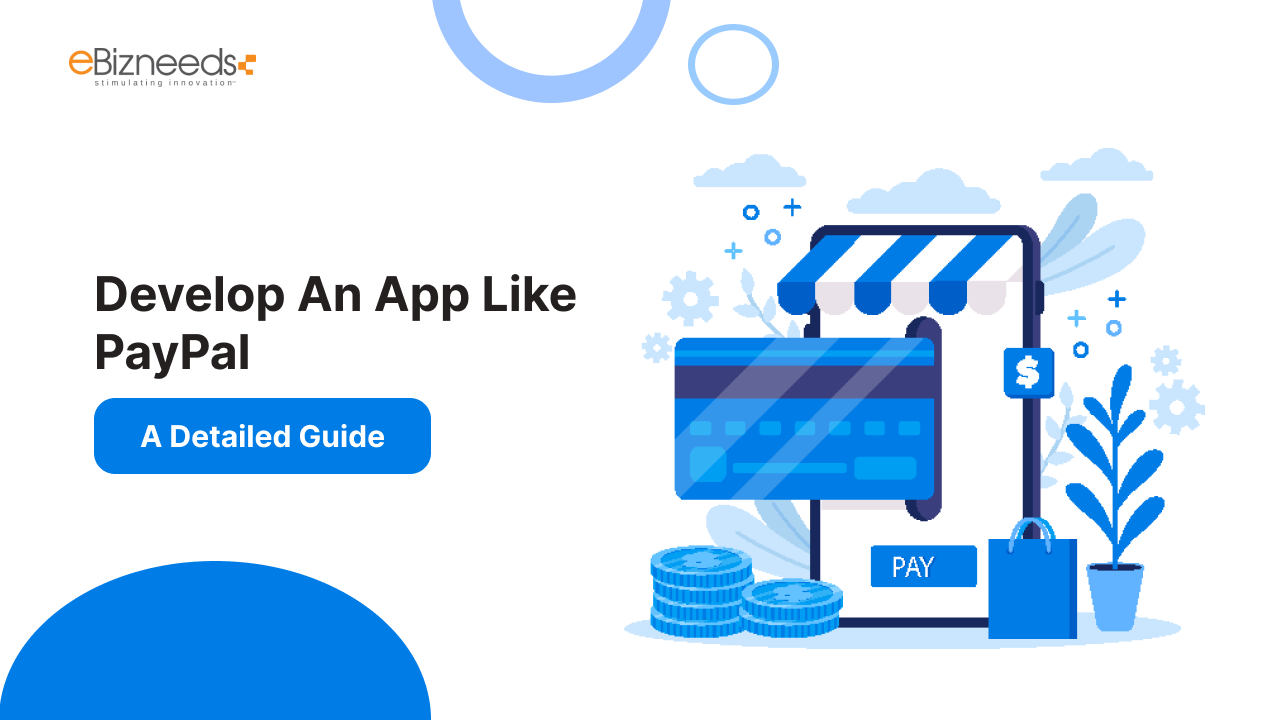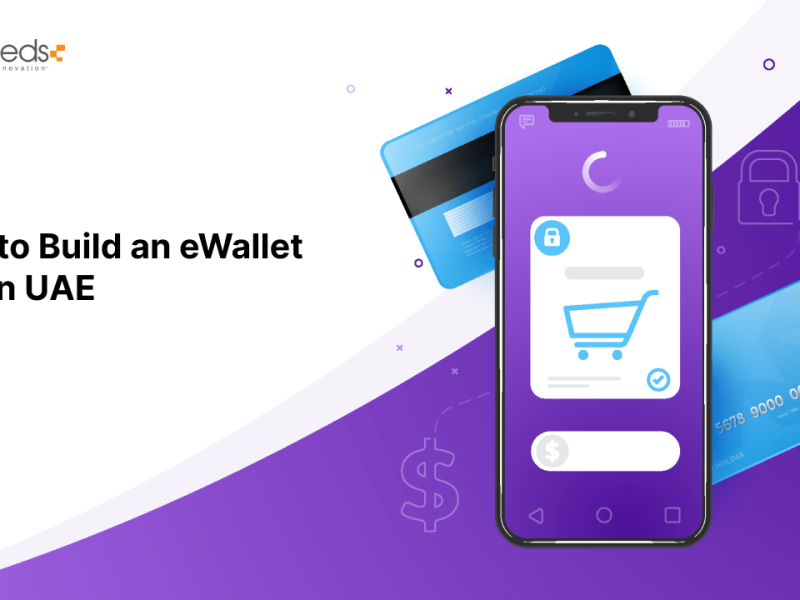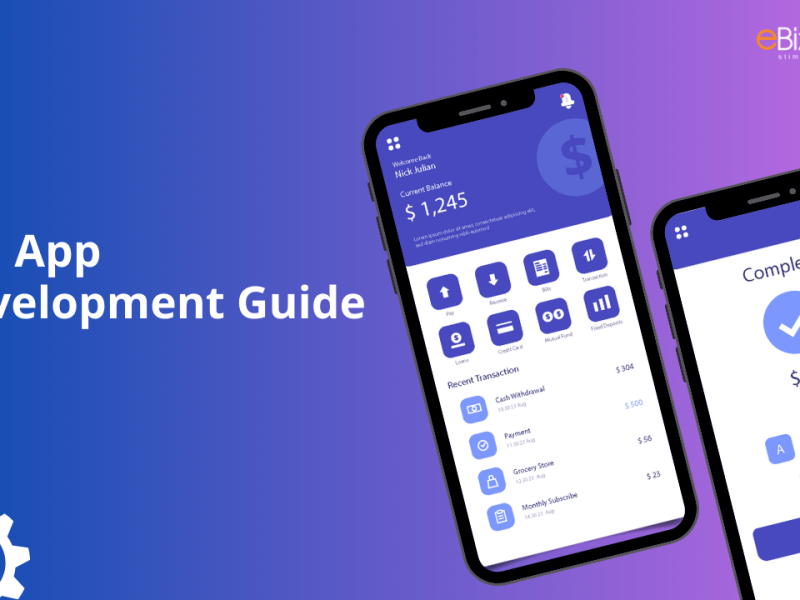Creating a powerful and secure app like PayPal can be a significant investment, often ranging from $100,000 to $300,000 depending on the app’s complexity and functionality.
This price tag, while steep, can be justified by the extensive features and security protocols required to match PayPal’s level of reliability and user trust.
Developing a digital wallet app like this means entering a space that has revolutionized how we think about money, payment security, and financial accessibility.
With millions worldwide using PayPal for transactions every day, building a similar platform could position you as a trusted financial solution provider in today’s fast-evolving digital economy.
So, what goes into the cost to develop an app like PayPal? Let’s dive into the details!
Understanding PayPal
PayPal is a leading online payment system that enables users to send, receive, and store funds digitally with ease and security.
Launched in 1998, it quickly became a trusted platform for businesses, freelancers, and individuals, allowing secure online transactions without sharing sensitive financial details.
Today, it operates in over 200 markets globally, serving as a convenient alternative to traditional banking.
With PayPal, users can link their bank accounts, debit cards, or credit cards, providing flexibility in managing funds.
PayPal’s versatility makes it useful for everything from paying bills and shopping online to receiving payments for freelance work or international money transfers.
The app offers additional services, including invoice generation, purchase protection, and integration with e-commerce platforms, making it an ideal choice for business transactions and personal payments alike.
Given its vast feature set and reputation for security, PayPal stands out as a leader in the e-wallet industry, setting a high standard for any similar app looking to break into this market.
Essential Features For PayPal-Like App
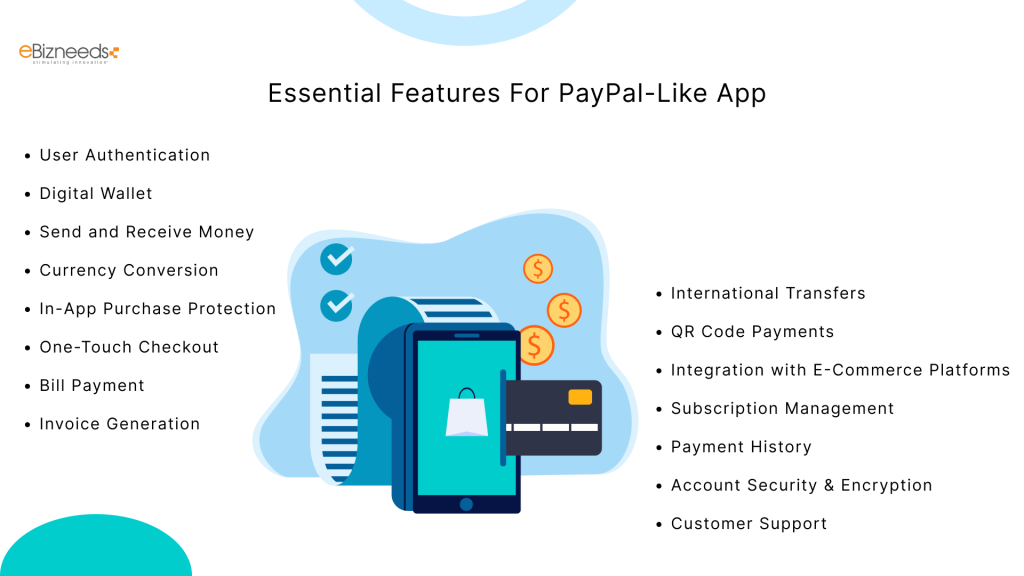


Here’s a list of PayPal’s features.
Right feature set help you target your audience’s pain point and deliver relief. These are:
1. User Authentication – Ensures secure logins with two-factor authentication for added security.
2. Digital Wallet – Stores funds and links multiple bank accounts or cards for flexible payments.
3. Send and Receive Money – Facilitates fast and convenient fund transfers to other users worldwide.
4. Currency Conversion – Allows transactions in multiple currencies with automatic conversion.
5. In-App Purchase Protection – Safeguards buyers with secure, refundable transactions for eligible purchases.
6. One-Touch Checkout – Streamlines online purchases with a single click, reducing cart abandonment.
7. Bill Payment – Enables users to pay bills directly from their account with ease.
8. Invoice Generation – Provides customizable invoicing for business transactions and freelancers.
9. International Transfers – Supports cross-border payments in a wide range of currencies.
10. QR Code Payments – Allows contactless payments via QR code scanning, perfect for in-person transactions.
11. Integration with E-Commerce Platforms – Offers seamless integration with popular e-commerce sites like eBay and Shopify.
12. Subscription Management – Simplifies managing subscriptions and recurring payments.
13. Payment History – Tracks transaction history for easy reference and financial management.
14. Account Security & Encryption – Uses advanced encryption methods to secure user data.
15. Customer Support – Provides 24/7 support via chat, phone, and email for user assistance.
Reasons To Go For It – Create An App Like PayPal in 2025
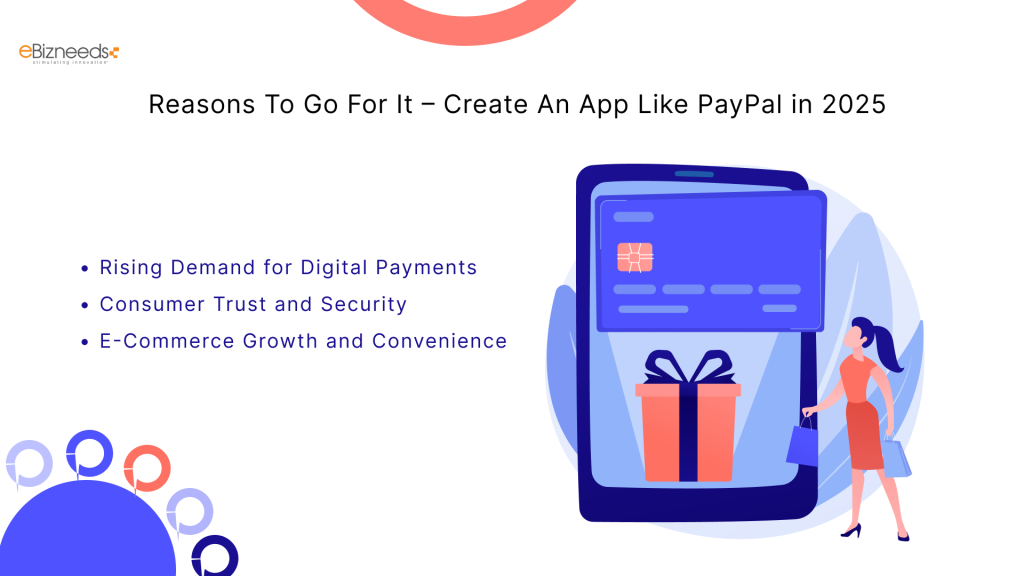


Creating an app like PayPal opens up the potential to serve a large, growing market for digital payments.
Here’s why it’s a smart move:
1. Rising Demand for Digital Payments
With the global digital payments market expected to reach $11.29 trillion by 2026, there’s a massive opportunity to tap into this space.
Users worldwide are increasingly looking for fast, reliable, and secure ways to manage transactions without depending on traditional banking channels.
2. Consumer Trust and Security
Digital wallets have gained tremendous trust over recent years.
Approximately 65% of consumers feel more secure using apps for payments than carrying cash, especially with features like two-factor authentication and encryption.
Building an app with robust security features can help you establish a reputation similar to PayPal’s.
3. E-Commerce Growth and Convenience
E-commerce is booming, and so is the demand for digital payment options.
PayPal reports that 28% of online shoppers are more likely to complete purchases when digital wallet options are available, particularly for one-touch checkouts.
This ease of use appeals to customers and increases conversion rates for businesses.
Launching a PayPal-like app means you can be at the forefront of this growth, offering secure, convenient, and accessible digital payment solutions for a wide range of users and businesses.
Average Cost to Develop an App Like PayPal – $100,000 – $300,000
Developing a feature-rich, secure app like PayPal requires a substantial investment.
The average cost to develop an app like PayPal generally ranges from $100,000 to $300,000.
This variation largely depends on the app’s complexity, the development team’s experience, and specific design and functionality requirements.
For a rough idea, here’s ewallet app development cost breakdown based on different stages:
| Development Stage | Estimated Cost |
| Design & Prototyping | $15,000 – $25,000 |
| Front-End Development | $30,000 – $60,000 |
| Back-End Development | $40,000 – $100,000 |
| Security Features | $10,000 – $25,000 |
| Testing & Quality Assurance | $10,000 – $20,000 |
| Deployment & Maintenance | $5,000 – $10,000 |
These estimates serve as a general guide and can vary based on your project’s unique specifications.



Choosing specific technologies or adding advanced features can also impact the final cost, which we’ll explore in more detail in the following section on cost-influencing factors.
Factors That Affect Cost To Develop an App Like PayPal
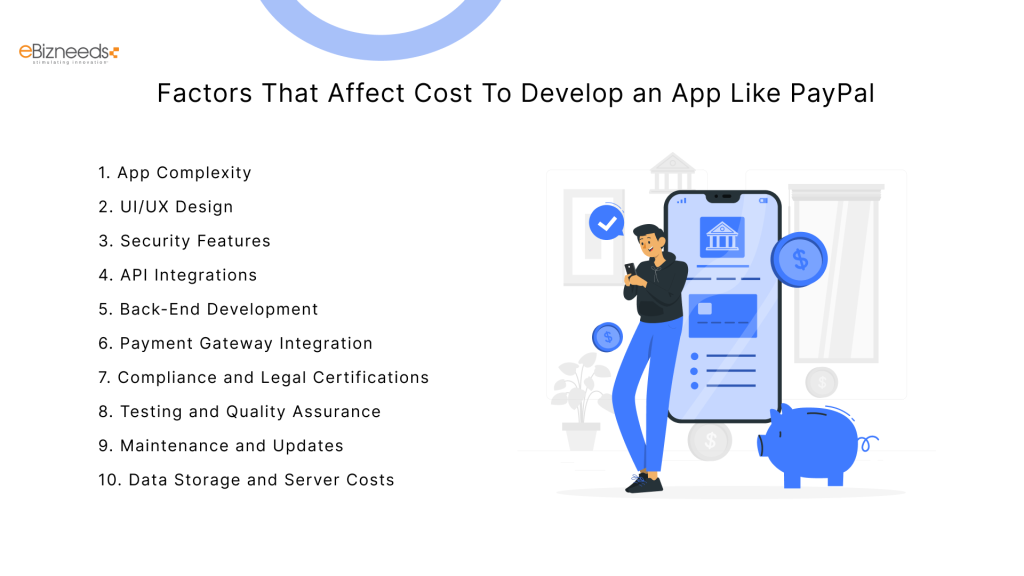


Calculating app development cost can be a complex task.
One of the key steps is considering all the factors that can affect eWallet app development cost.
Let’s look at some of these important factors and how they affect total cost:
1. App Complexity
App complexity is one of the most significant factors influencing development costs.
A basic app might include core features like user registration, basic authentication, and single-currency transactions.
As complexity increases, more sophisticated features like multi-currency support, custom user dashboards, and AI-driven fraud detection add layers of functionality and security.
Complex apps also require more testing and integration efforts, increasing development timelines.
| Complexity Level | Features Included | Estimated Cost |
| Basic | User authentication, single payment gateway | $60,000 – $100,000 |
| Intermediate | Multi-currency, basic analytics, notifications | $100,000 – $150,000 |
| Advanced | AI fraud detection, API integrations, BI tools | $150,000 – $250,000+ |
2. UI/UX Design
A strong UI/UX design attracts users and enhances their experience, which is crucial for retention.
Simple interfaces may only require basic color schemes and layouts, while advanced designs incorporate custom graphics, animations, and an intuitive flow for ease of use.
High-quality design involves wireframing, prototyping, and user testing to ensure an app that’s both visually appealing and functional.
Here’s a breakdown of UI/UX design cost:
| Design Complexity | Features Included | Estimated Cost |
| Basic | Standard layouts, minimal animations | $10,000 – $20,000 |
| Moderate | Custom visuals, basic animations, smooth transitions | $20,000 – $35,000 |
| Advanced | High-level custom graphics, complex animations | $35,000 – $50,000 |
3. Security Features
Security features are a top priority for financial apps.
Essential security protocols include data encryption, secure data storage, and multi-factor authentication.
Enhanced security requires features like biometric login, fraud detection algorithms, and compliance with international standards such as PCI DSS.
Advanced security investments reduce risks but can increase the budget substantially.
| Security Level | Features Included | Estimated Cost |
| Basic | Data encryption, two-factor authentication | $10,000 – $15,000 |
| Advanced | Biometric login, IP whitelisting, encryption algorithms | $15,000 – $25,000 |
| Enterprise-grade | PCI DSS compliance, continuous monitoring | $25,000 – $40,000 |
4. API Integrations
APIs enable seamless interaction between your app and external services.
For PayPal-like apps, essential APIs might include currency conversion, payment gateways, and transaction tracking.
More complex integrations like those for AI analytics or advanced fraud detection further raise costs, as they involve custom setups and testing to ensure stability and security.
| Integration Type | Examples of APIs Included | Estimated Cost |
| Basic | Currency conversion, single payment gateway | $5,000 – $10,000 |
| Moderate | Multi-payment gateways, customer support integration | $10,000 – $20,000 |
| Complex | AI analytics, custom fraud detection systems | $20,000 – $30,000+ |
5. Back-End Development
A well-structured back-end architecture ensures data processing, server management, and app scalability.
Basic systems use shared servers and simple databases.
While advanced setups may require dedicated servers, cloud solutions, and custom databases to handle large volumes of transactions efficiently.
| Back-End Complexity | Features and Infrastructure | Estimated Cost |
| Basic | Shared server, SQL database, simple processing | $20,000 – $40,000 |
| Intermediate | Dedicated server, SQL/NoSQL hybrid, scalable design | $40,000 – $80,000 |
| Advanced | Cloud servers, complex databases, API management | $80,000 – $150,000 |
6. Payment Gateway Integration
To provide users with payment flexibility, integrating multiple gateways is key.
Each payment gateway requires specific setup, testing, and integration work, and using popular options like PayPal, Stripe, or Apple Pay improves user choice.
But also adds to the costs due to custom configurations and additional security needs.
| Payment Gateway | Features | Estimated Cost |
| Single Gateway | Basic integration (e.g., Stripe or PayPal) | $5,000 – $10,000 |
| Two Gateways | PayPal and secondary gateway for redundancy | $10,000 – $15,000 |
| Multiple Gateways | Custom setup for 3+ gateways, added payment security | $15,000 – $25,000 |
7. Compliance and Legal Certifications
Apps handling sensitive data must comply with standards like GDPR, PCI DSS, and local regulations.
This includes developing secure data handling practices, maintaining encryption standards, and following audit protocols.
Compliance costs can include third-party audits, legal consultations, and additional security features to meet certification requirements.
| Compliance Type | Regulations Covered | Estimated Cost |
| GDPR | Data protection, user consent management | $5,000 – $10,000 |
| PCI DSS | Secure data handling, transaction security | $10,000 – $20,000 |
| Complete Compliance | All necessary local and international certifications | $20,000 – $30,000 |
8. Testing and Quality Assurance
Thorough testing is essential for any financial app.
Functional testing ensures each feature works correctly, while security and performance testing guarantee the app’s resilience under real-world conditions.
Testing costs can increase with the complexity of the app, as more scenarios and stress tests are needed to ensure reliability.
| Testing Type | Features Covered | Estimated Cost |
| Basic Testing | Basic functionality tests | $5,000 – $10,000 |
| Intermediate Testing | User acceptance, device compatibility testing | $10,000 – $20,000 |
| Advanced Testing | Load testing, penetration testing, stress testing | $20,000 – $30,000 |
9. Maintenance and Updates
Maintenance is vital to keep the app functioning optimally after launch.
This may involve server updates, bug fixes, and regular security patches.
Complex apps with advanced features often require more frequent updates and monitoring, increasing the recurring maintenance cost.
| Maintenance Type | Scope of Maintenance | Annual Cost |
| Basic | Minor bug fixes, occasional updates | $10,000 – $15,000 |
| Intermediate | Monthly updates, security checks | $15,000 – $25,000 |
| Advanced | Continuous monitoring, frequent updates | $25,000 – $40,000 |
10. Data Storage and Server Costs
Storing and processing transaction data for a payment app can require significant server infrastructure.
Costs vary depending on whether you choose a cloud-based solution or dedicated servers.
Large-scale apps with high transaction volumes may also need additional storage solutions and processing power for data-intensive operations.
| Server Type | Features and Capabilities | Estimated Cost |
| Cloud-based | Flexible storage, scalable usage | $5,000 – $15,000 |
| Dedicated | High processing power, isolated security | $15,000 – $30,000 |
| Enterprise-grade | High availability, robust redundancy | $30,000 – $50,000 |
Steps To Create An App Like PayPal
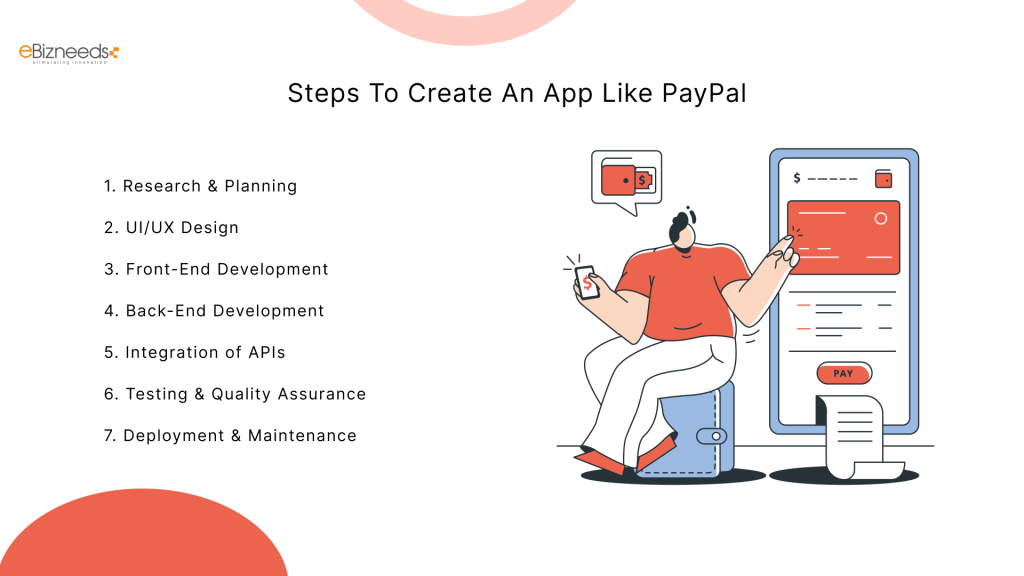


Developing an app like PayPal involves a streamlined, well-organized process to ensure a secure and functional product.
Here’s a breakdown of the key stages:
1. Research & Planning
Define the app’s goals, target audience, and core features.
This phase includes competitive analysis, requirements gathering, and budgeting.
2. UI/UX Design
Design a user-friendly interface with prototypes and wireframes to map the user journey, making the app intuitive and visually appealing.
3. Front-End Development
Build the client-facing side of the app with interactive features, layouts, and design elements that create a seamless user experience.
4. Back-End Development
Develop the server side for data management, authentication, and secure processing, ensuring robust performance and scalability.
5. Integration of APIs
Add necessary third-party APIs for features like currency conversion, payment gateways, and notifications.
6. Testing & Quality Assurance
Conduct rigorous testing to ensure functionality, security, and performance, with fixes for any identified issues.
7. Deployment & Maintenance
Launch the app on platforms like Google Play and Apple Store, followed by ongoing maintenance for updates and enhancements.
Each stage plays a critical role in delivering a secure, efficient app that meets user expectations.
PayPal App Development Timeline
The timeline to develop an app like PayPal typically ranges from 6 to 12 months, depending on the app’s complexity and feature set.
Here’s a breakdown of each phase with estimated durations:
| Development Stage | Estimated Duration |
| Research & Planning | 2 – 4 weeks |
| UI/UX Design | 4 – 6 weeks |
| Front-End Development | 6 – 10 weeks |
| Back-End Development | 8 – 12 weeks |
| API Integrations | 3 – 5 weeks |
| Testing & Quality Assurance | 4 – 6 weeks |
| Deployment | 1 – 2 weeks |
The timeline may vary based on the team size, scope of features, and any customizations required.
Complex security features or multiple payment gateways can add extra weeks to the development time.
Investing time in each stage is essential to create a high-quality app that meets industry standards.
A well-planned timeline allows for thorough testing and refinements, ensuring a smooth user experience upon launch.
Monetizing PayPal App Clone
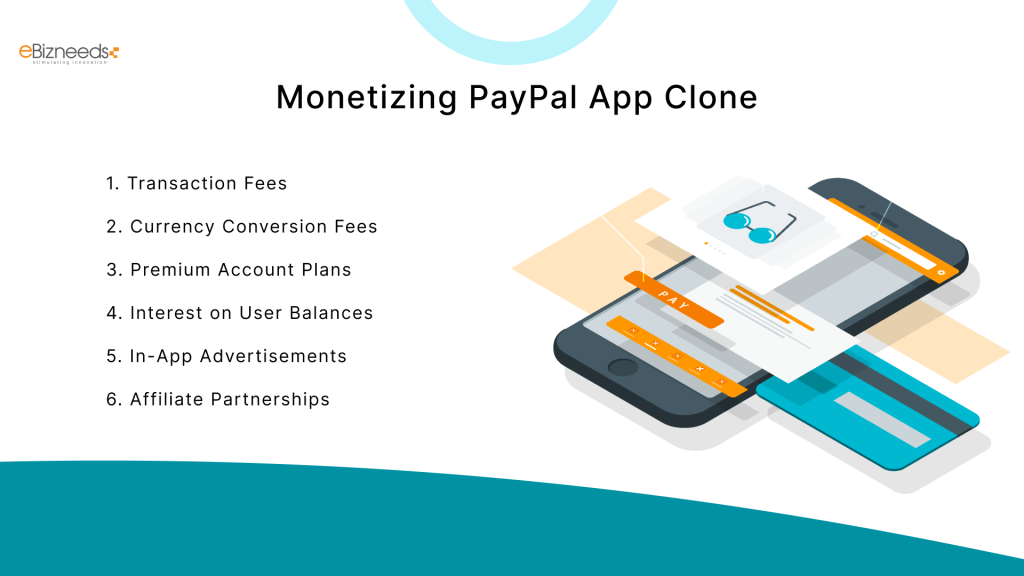


Monetizing an app like PayPal involves strategic revenue streams designed to generate consistent income.
Here are some popular methods:
1. Transaction Fees
Charging a small fee per transaction is one of the most common revenue streams.
Apps often apply fees for cross-border transactions, instant transfers, or payments above a certain amount.
For instance, a 2-3% fee on international transactions can generate substantial income, especially in high-transaction apps.
2. Currency Conversion Fees
Adding a currency conversion fee on international payments is another profitable approach.
This fee, generally around 1-2%, covers the exchange process, making it a viable revenue stream as users increasingly make cross-border payments.
Offering premium memberships with added features like higher transaction limits or priority support can attract businesses or high-volume users.
Premium accounts may generate steady revenue by charging monthly or yearly fees.
4. Interest on User Balances
Holding user funds in the app’s wallet allows the company to earn interest.
By investing these funds, the app can generate passive income while providing users with quick transaction options.
5. In-App Advertisements
Strategic in-app ads, like targeted promotions for financial products, can bring in revenue without disrupting the user experience.
Partnering with relevant advertisers can increase ROI while maintaining app quality.
6. Affiliate Partnerships
Partner with e-commerce platforms or financial services to offer special discounts or incentives through your app.
This can earn commissions from affiliate links, driving additional revenue from partner transactions.
These monetization methods offer reliable revenue potential, helping you make your app financially sustainable while providing value to users.
eBizneeds – Your Partner in eWallet App Development
When it comes to building a high-quality eWallet app like PayPal, eBizneeds is here to make your vision a reality.
Our team brings extensive experience in developing secure, scalable, and user-friendly eWallet applications tailored to meet modern business needs.
From conceptualizing features that set your app apart to implementing robust security protocols, we handle every stage of development with precision and care.
At eBizneeds, we’re committed to delivering solutions that are not only efficient but also align with industry standards, ensuring your app stands out in today’s competitive market.
Ready to build your app with a trusted eWallet app development company? Connect with eBizneeds to start your project!
Conclusion
Creating an app like PayPal involves strategic planning, a strong feature set, and attention to security.
While the cost to develop an app like this can range widely, each investment contributes to building a platform that users can trust for seamless and secure transactions.
By carefully considering factors such as complexity, security, API integrations, and maintenance, you can develop a robust digital wallet that meets market demands and user expectations.
With the right development partner, such as eBizneeds, you can navigate the challenges of eWallet app development to create an app that competes with industry giants.
As digital payments continue to grow, now is the time to take your place in this booming sector.
FAQs
The cost to develop an app like PayPal ranges from $100,000 to $300,000, depending on features, security, integrations, and complexity.
Essential features include user authentication, multi-currency support, transaction history, fraud detection, and integration with various payment gateways.
Developing an app like PayPal typically takes 6 to 12 months, including research, design, development, and testing.
Monetization strategies include transaction fees, currency conversion fees, premium accounts, and partnerships with financial service providers.
Security is vital because eWallets handle sensitive financial data. Strong security features like encryption, two-factor authentication, and compliance with regulations help protect user information and build trust.



Naveen Khanna is the CEO of eBizneeds, a company renowned for its bespoke web and mobile app development. By delivering high-end modern solutions all over the globe, Naveen takes pleasure in sharing his rich experiences and views on emerging technological trends. He has worked in many domains, from education, entertainment, banking, manufacturing, healthcare, and real estate, sharing rich experience in delivering innovative solutions.
